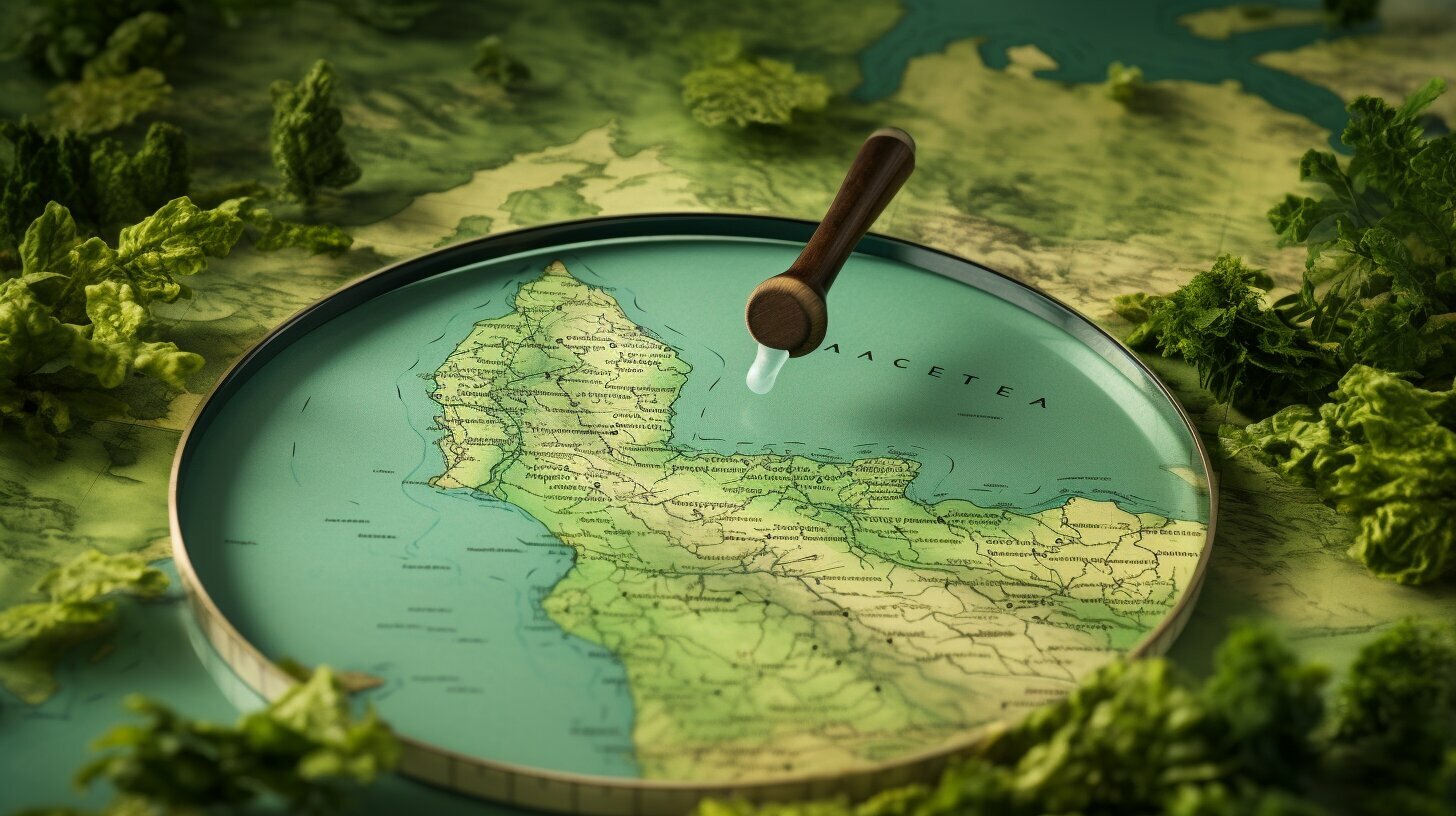What country is Costa Rica in
Costa Rica is a captivating country located in Central America, boasting a strategic position in this vibrant region. It is bordered by Nicaragua to the north, the Caribbean Sea to the northeast, Panama to the southeast, and the Pacific Ocean to the southwest. This beautiful nation is known for its stable and democratic government, high literacy rates, and commitment to the environment. With a diverse landscape that includes mountain ranges, volcanoes, coastal plains, and rainforests, Costa Rica offers a unique blend of natural beauty and cultural richness. Its economy has thrived, transitioning from agriculture to services and technology. As a top tourist destination, Costa Rica continues to attract visitors with its stunning landscapes and warm hospitality. The capital city of Costa Rica is San José.
Key Takeaways:
- Costa Rica is located in Central America, with borders including Nicaragua, the Caribbean Sea, Panama, and the Pacific Ocean.
- It is known for its stable government, high literacy rates, and commitment to the environment.
- The country offers a diverse landscape, featuring mountain ranges, volcanoes, coastal plains, and rainforests.
- Costa Rica’s economy has shifted from agriculture to services and technology.
- The capital city of Costa Rica is San José.
Costa Rica’s Geographical Features and Borders
Nestled in Central America, Costa Rica is a land of breathtaking geographical diversity and is characterized by a stunning array of natural wonders. From rugged mountain ranges and majestic volcanoes to the tranquil beauty of coastal plains and lush rainforests, this small country offers a rich tapestry of landscapes waiting to be explored.
Costa Rica is bordered by Nicaragua to the north, the Caribbean Sea to the northeast, Panama to the southeast, and the Pacific Ocean to the southwest. These natural boundaries not only foster a unique blend of cultures and influences but also contribute to the country’s reputation as a peaceful and stable nation in the region.
Within its borders, Costa Rica boasts an impressive collection of national parks and protected areas, preserving its pristine ecosystems and providing habitats for an incredible variety of plant and animal species. This commitment to environmental conservation has earned Costa Rica international recognition and made it a popular destination for eco-tourism.
Whether you’re seeking thrilling adventures such as hiking through tropical rainforests, exploring active volcanoes, or relaxing on pristine beaches, Costa Rica’s diverse geography offers something for everyone. The warm hospitality of its people, known as Ticos, and the country’s dedication to sustainable development create an unforgettable experience for visitors from around the world.
| Geographical Features | Borders |
|---|---|
| Mountain ranges | Nicaragua (north) |
| Volcanoes | Caribbean Sea (northeast) |
| Coastal plains | Panama (southeast) |
| Rainforests | Pacific Ocean (southwest) |
Costa Rica’s Unique Biodiversity
One of the most remarkable aspects of Costa Rica’s geography is its extraordinary biodiversity. Despite its small size, the country is home to nearly 6% of the world’s plant and animal species. This abundance of life can be attributed to the country’s varied ecosystems, which range from lowland rainforests to cloud forests, mangroves, and coral reefs.
With over 25% of its land designated as protected areas, Costa Rica places a strong emphasis on conservation and sustainability. Visitors can embark on guided tours to witness rare and endemic species, such as the iconic resplendent quetzal, the endangered green sea turtle, and the three-toed sloth.
Costa Rica’s commitment to preserving its natural heritage not only benefits its diverse flora and fauna but also provides opportunities for scientific research and eco-tourism. This unique combination of environmental stewardship and awe-inspiring landscapes makes Costa Rica a true gem within the heart of Central America.
Costa Rica’s Position in Central America
As a proud member of the Central American region, Costa Rica holds a significant place, both geographically and culturally, within this dynamic area. Located in the heart of Central America, Costa Rica shares its borders with Nicaragua to the north and Panama to the southeast. The country is also blessed with natural beauty, boasting access to both the Caribbean Sea to the northeast and the Pacific Ocean to the southwest.
Costa Rica’s strategic position has not only shaped its geographical features but also influenced its cultural and historical development. The country’s diverse landscape is a testament to its unique location, with towering mountain ranges, active volcanoes, breathtaking coastal plains, and lush rainforests. This natural wealth has made Costa Rica a haven for biodiversity and eco-tourism, attracting visitors from around the globe.
Within the Central American region, Costa Rica stands out for its peaceful and democratic society. It has a stable government, a commitment to environmental protection, and high literacy rates. The country has also made significant progress in shifting its economy from agriculture to services and technology, establishing itself as a leading hub for innovation and entrepreneurship in the region.
Costa Rica’s Role in Central America
Costa Rica plays an integral role within the Central American community, actively engaging in regional diplomacy and cooperation. The country has a strong commitment to peace and stability, which is reflected in its long-standing tradition of not having a military. Instead, it allocates significant resources to education, healthcare, and environmental conservation.
Moreover, Costa Rica is a vocal advocate for regional integration and collaboration. It has played a key role in initiatives such as the Central American Integration System (SICA) and the Central American Free Trade Agreement (CAFTA), working towards economic development and closer ties among Central American nations.
In summary, Costa Rica’s position in Central America is both geographically and culturally significant. The country’s natural beauty, stable government, and commitment to sustainable development make it a standout nation within the region. As Costa Rica continues to thrive and contribute to the Central American community, it remains a shining example of progress and harmony in Central America.
| Geographical Features | Borders | Notable Features |
|---|---|---|
| Mountain ranges, volcanoes, coastal plains, rainforests | Nicaragua to the north, Panama to the southeast | Stable government, high literacy rates, commitment to the environment, popular tourist destination |
Costa Rica’s Global Connections and Influence
Costa Rica’s impact extends beyond its borders, as it actively engages with the international community and contributes to the progress of the American continent. The country’s commitment to peace, democracy, and environmental conservation has earned it a reputation as a global leader. Costa Rica holds a prominent position within international organizations, such as the United Nations and the Organization of American States, where it advocates for sustainable development, human rights, and social justice.
As a country known for its stable government and high literacy rates, Costa Rica attracts foreign investment and fosters a vibrant entrepreneurial spirit. Its growing economy has shifted from traditional agriculture to thriving sectors like services and technology. Costa Rica’s strategic location and favorable business climate have attracted multinational corporations seeking to establish regional headquarters in the country, further strengthening its global connections and influence.
In addition to its economic prowess, Costa Rica also boasts a rich cultural heritage. Its commitment to education and social welfare has shaped a society that values inclusivity and equality. This dedication to social progress has not gone unnoticed on the global stage. The country has been recognized for its achievements in education, healthcare, and sustainable development, earning the admiration and respect of its international partners.
Costa Rica’s Environmental Stewardship
One of Costa Rica’s most significant contributions to the world is its commitment to environmental conservation. Known for its breathtaking biodiversity, the country is home to numerous national parks and protected areas. By setting aside vast expanses of land for conservation, Costa Rica has become a sanctuary for countless species, both flora and fauna. Its efforts have not only benefited local ecosystems but have also had a global impact by promoting sustainable practices and inspiring other nations to follow suit.
The preservation of Costa Rica’s natural resources goes hand in hand with its dedication to renewable energy. The country has set ambitious goals to become carbon neutral by 2050, and it has already made significant progress in harnessing its abundant natural resources for power generation. Costa Rica’s success in renewable energy serves as a model for other countries, illustrating how sustainable practices can be integrated into national development strategies.
| Key Points | Facts |
|---|---|
| Country | Costa Rica |
| Continent | America |
| Location | Central America |
| Borders | Nicaragua (north), Caribbean Sea (northeast), Panama (southeast), Pacific Ocean (southwest) |
| Capital City | San José |
Costa Rica’s Capital City and Notable Features
At the heart of Costa Rica lies its vibrant capital city, San José, which serves as a testament to the nation’s rich heritage and modern achievements. San José is a bustling metropolis that seamlessly blends historical landmarks with contemporary attractions, offering visitors a captivating experience.
One of the remarkable features of San José is its architectural beauty. The city is home to stunning colonial-era buildings, such as the iconic National Theatre, a masterpiece adorned with elaborate frescoes and gilt decorations. Walking through the city’s streets, you will discover charming plazas, bustling markets, and quaint neighborhoods that showcase the country’s cultural diversity.
Aside from its architectural treasures, San José is also a cultural hub, boasting numerous museums and galleries. The Costa Rican Art Museum houses a vast collection of works from renowned national artists, while the Pre-Columbian Gold Museum showcases the country’s rich indigenous heritage. Visitors can immerse themselves in the vibrant local art scene by exploring the city’s many galleries and attending cultural events.
San José not only offers a glimpse into Costa Rica’s past, but it also reflects the nation’s commitment to progress and sustainability. The city’s Central Park symbolizes this dedication, with its lush green spaces and sustainable design. As the country’s economic and political center, San José is a hub for innovation and technology, attracting international businesses and entrepreneurs.
FAQ
Q: What country is Costa Rica in?
A: Costa Rica is located in Central America.
Q: What are Costa Rica’s borders?
A: Costa Rica is bordered by Nicaragua to the north and Panama to the southeast.
Q: What bodies of water surround Costa Rica?
A: Costa Rica is bordered by the Caribbean Sea to the northeast and the Pacific Ocean to the southwest.
Q: What is the capital city of Costa Rica?
A: The capital city of Costa Rica is San José.
Q: What is the geography of Costa Rica like?
A: Costa Rica has a diverse landscape that includes mountain ranges, volcanoes, coastal plains, and rainforests.
Q: What is the economy of Costa Rica like?
A: Costa Rica’s economy has shifted from agriculture to services and technology.
Q: Why is Costa Rica popular as a tourist destination?
A: Costa Rica is known for its stable and democratic government, high literacy rates, commitment to the environment, and its natural beauty.



